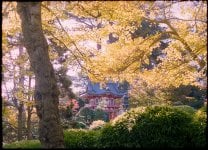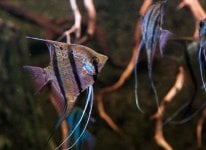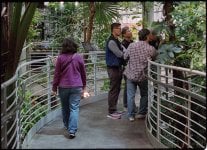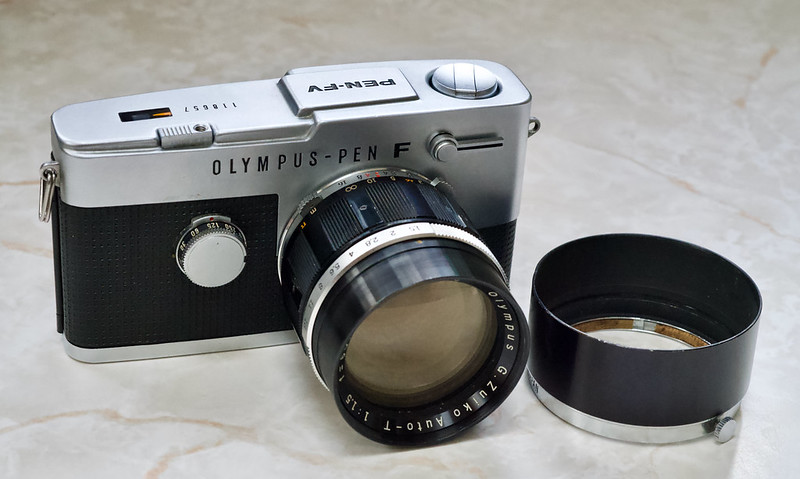chrism
Well-known
I was always well-disposed towards Olympus. My first proper camera was a Trip 35, and I was dreadfully jealous of my brother's OM-1. For reasons now forgotten, my wife bought a used Pen FT in 1977, and travelled quite a bit with it. She was probably impressed with the idea of film costing only half as much as usual. She had an ever ready case, the 38mm/f1.8 and a 150mm/f4, which was far from the most useful second lens, but we were young and knew no better. Years later I resurrected the camera, with a battery adapter and some zinc-air hearing aid batteries, along with a 25mm/f4 lens (roughly like a 35mm on normal 135 film). I didn't find the meter very accurate, and I read how the viewfinder was darker because of the light being diverted to the meter. So I obtained a Pen F (it has a ground glass focusing screen but it is still easier to focus than the dark microprisms of the FT's screen), and used the same handheld meter I'd got used to using with medium and large format cameras. It's smaller and lighter than a Leica M, and you would need a microscope to see the differences in the results from the lenses.
In the last few years, I have had the chance to explore something that dates me dreadfully - avoiding grain. When I was young, wide aperture lenses were beyond my means, so faster film was the answer, and that meant grain. No one liked it then, rather than today's attitude that grain shows you're a real photographer using real film. We did what we could with so-called fine grain developers, but the answer to all this finally came by accident, when C-41 process B&W films were sold. Since these films have extremely fine grain (after all, they have minimal amounts of silver just to activate the dyes), and can be developed at various speeds in conventional B&W developers with next to no graininess, I recently thought of a torture test for this combination of film and developer. Why not use the Pen F, which will instantly double grain size given the half-sized negative, and rate the XP2 Super at 1600 just to make it difficult? I make no claims for the value of the photo, but it does illustrate that half-frame and this film can make decent pictures. This is a triptych of half-frame XP2 Super at 1600 developed in 1+49 HC-110 for 18 minutes:

This one was FP4, before I discovered XP2:

And this was Kodachrome 64:

So what am I to do with this now? There is a meterless Pen F with a bright viewfinder and a microprism focusing screen, and it's the Pen FV. One is coming. There is also a shockingly expensive portrait lens of 60mm/f1.5. One is coming. Madness is a real thing, and maybe some of that is coming too. We shall see. Maybe the madness has been a long time coming: here is a 4x5 photo of some of the Olympus cameras I owned:

In the meantime, do please, post some half-frame photos here.
In the last few years, I have had the chance to explore something that dates me dreadfully - avoiding grain. When I was young, wide aperture lenses were beyond my means, so faster film was the answer, and that meant grain. No one liked it then, rather than today's attitude that grain shows you're a real photographer using real film. We did what we could with so-called fine grain developers, but the answer to all this finally came by accident, when C-41 process B&W films were sold. Since these films have extremely fine grain (after all, they have minimal amounts of silver just to activate the dyes), and can be developed at various speeds in conventional B&W developers with next to no graininess, I recently thought of a torture test for this combination of film and developer. Why not use the Pen F, which will instantly double grain size given the half-sized negative, and rate the XP2 Super at 1600 just to make it difficult? I make no claims for the value of the photo, but it does illustrate that half-frame and this film can make decent pictures. This is a triptych of half-frame XP2 Super at 1600 developed in 1+49 HC-110 for 18 minutes:

This one was FP4, before I discovered XP2:

And this was Kodachrome 64:

So what am I to do with this now? There is a meterless Pen F with a bright viewfinder and a microprism focusing screen, and it's the Pen FV. One is coming. There is also a shockingly expensive portrait lens of 60mm/f1.5. One is coming. Madness is a real thing, and maybe some of that is coming too. We shall see. Maybe the madness has been a long time coming: here is a 4x5 photo of some of the Olympus cameras I owned:

In the meantime, do please, post some half-frame photos here.
Agiknee
Documentarian
I love the pen series cameras. I only have the ee2 but it still has a working selenium meter and continues to expose properly. I’d eventually love to stumble on a pen F SLR at a reasonable price. The half frame negative makes a fairly good printable 5x7 print and the lens has character.
neal3k
Well-known
Great Pen F overview. I really enjoyed it.
I started Olympus cameras with a new OM-1 back in the 1970s.. Only relatively recently did I finally get a Pen FT. I read it was a bit dim in the viewfinder but thought it would be OK and I liked the idea of a meter. After using it a bit, I disliked the dim image more than I expected and was frustrated by the odd exposure meter. I sold the FT and bought a Pen F. It is great. I usually shoot in bright sunlight and use sunny 16 so I don't even need the meter and my phone meter is there if I need it. I've always liked grain but like what you said about C-41 B&W films and may have to try it.
Here are a few shots I have taken with both the FT and the F. Please see Flickr if you want more info.
 Polyptych Locomotive #7 by Neal Wellons, on Flickr
Polyptych Locomotive #7 by Neal Wellons, on Flickr
 Fall at the Pond by Neal Wellons, on Flickr
Fall at the Pond by Neal Wellons, on Flickr
 Under the Awning by Neal Wellons, on Flickr
Under the Awning by Neal Wellons, on Flickr
 M.W. is Holding Up Well at 116 by Neal Wellons, on Flickr
M.W. is Holding Up Well at 116 by Neal Wellons, on Flickr
 Magnolia in McDonough by Neal Wellons, on Flickr
Magnolia in McDonough by Neal Wellons, on Flickr
I started Olympus cameras with a new OM-1 back in the 1970s.. Only relatively recently did I finally get a Pen FT. I read it was a bit dim in the viewfinder but thought it would be OK and I liked the idea of a meter. After using it a bit, I disliked the dim image more than I expected and was frustrated by the odd exposure meter. I sold the FT and bought a Pen F. It is great. I usually shoot in bright sunlight and use sunny 16 so I don't even need the meter and my phone meter is there if I need it. I've always liked grain but like what you said about C-41 B&W films and may have to try it.
Here are a few shots I have taken with both the FT and the F. Please see Flickr if you want more info.
 Polyptych Locomotive #7 by Neal Wellons, on Flickr
Polyptych Locomotive #7 by Neal Wellons, on Flickr Fall at the Pond by Neal Wellons, on Flickr
Fall at the Pond by Neal Wellons, on Flickr Under the Awning by Neal Wellons, on Flickr
Under the Awning by Neal Wellons, on Flickr M.W. is Holding Up Well at 116 by Neal Wellons, on Flickr
M.W. is Holding Up Well at 116 by Neal Wellons, on Flickr Magnolia in McDonough by Neal Wellons, on Flickr
Magnolia in McDonough by Neal Wellons, on Flickrchrism
Well-known
Ha! We have a couple of struggling magnolias in our garden that don't care for the Nova Scotian climate too much. Just noticed a few days ago that they have red berries, which I hadn't seen before. Your colour photos illustrate very well how the tiny negative need not be grainy.
More, please!
More, please!
neal3k
Well-known
Thanks but the magnolias may be my best. I'll add one more while we wait for more from other members. This is a group of half-frame photos I took before I got my Olympus Pens. It is from a Canon demi half-frame using Kodak Ektar 100 film.
 An Americus Panorama in Six Halves by Neal Wellons, on Flickr
An Americus Panorama in Six Halves by Neal Wellons, on Flickr
 An Americus Panorama in Six Halves by Neal Wellons, on Flickr
An Americus Panorama in Six Halves by Neal Wellons, on FlickrRicoh
Well-known
Yes,. definitely.
All taken with the Pen FT with 70mm f2 - great lens.
https://flic.kr/p/26Z1UNG]
 [/url]ClitheroeRooftops by -Steve Ricoh-
[/url]ClitheroeRooftops by -Steve Ricoh-
https://flic.kr/p/HfW1X8]
 [/url]Curves by -Steve Ricoh-
[/url]Curves by -Steve Ricoh-
https://flic.kr/p/26G4srD]
 [/url]Joyce by -Steve Ricoh-
[/url]Joyce by -Steve Ricoh-
https://flic.kr/p/J3ZS9J]
 [/url]The lady and the butcher by -Steve Ricoh-
[/url]The lady and the butcher by -Steve Ricoh-
All taken with the Pen FT with 70mm f2 - great lens.
https://flic.kr/p/26Z1UNG]

https://flic.kr/p/HfW1X8]

https://flic.kr/p/26G4srD]

https://flic.kr/p/J3ZS9J]

chrism
Well-known
Godfrey
somewhat colored
I've owned a few Pen F and FT cameras over the years. Excellent lenses, a very handy camera! They were always capable of making excellent photos, as the pictures in this thread show, with the usual limitations of any small film format (not much limitation if you're usual photo output is modest sized prints up to an 11x14 inch...). 
G
G
JeffS7444
Well-known
Retro-Grouch
Mentor
Oh, no! I feel a GAS attack... I always thought that the half-frame F cameras were gorgeous, but I dismissed the format out of hand as being just too small for quality work. Clearly, I've been mistaken. If I'm lucky, there won't be any on the auction site until after the attack subsides.
JeffS7444
Well-known
JeffS7444
Well-known
chrism
Well-known
Ricoh
Well-known
^ one of the benefits of the 1/2 frame.
Anyone contemplating should know it can take a long time to ‘burn’ though 72 shots, sometimes months. The current roll has been in the camera for over 12 months. I try moving it along by shooting diptychs, triptychs and sometimes panotychs. Switching to 24 exp cassettes would be sensible, but not economic so I always use the longer length film.
Anyone contemplating should know it can take a long time to ‘burn’ though 72 shots, sometimes months. The current roll has been in the camera for over 12 months. I try moving it along by shooting diptychs, triptychs and sometimes panotychs. Switching to 24 exp cassettes would be sensible, but not economic so I always use the longer length film.
Godfrey
somewhat colored
^ one of the benefits of the 1/2 frame.
Anyone contemplating should know it can take a long time to ‘burn’ though 72 shots, sometimes months. The current roll has been in the camera for over 12 months. I try moving it along by shooting diptychs, triptychs and sometimes panotychs. Switching to 24 exp cassettes would be sensible, but not economic so I always use the longer length film.
Having gotten accustomed to working with Polaroid (8 shots per pack) and 6x6 (12 shots per roll), there are times when even a roll of 135-24 in a full frame camera seems to take forever to work through!
G
neal3k
Well-known
Re: 72 frames take so long to shoot.
When I'm ready to see my work, and I've got lots of unexposed images left, I open the camera in my dark bag, pull out a couple of inches of film from the can, snip and load the exposed film into my developing tank. Then I open the bag, cut a new leader and reload. Of course you loose a few frames but not a big deal when you start with 72.
When I'm ready to see my work, and I've got lots of unexposed images left, I open the camera in my dark bag, pull out a couple of inches of film from the can, snip and load the exposed film into my developing tank. Then I open the bag, cut a new leader and reload. Of course you loose a few frames but not a big deal when you start with 72.
Ricoh
Well-known
⬆️ Being very careful to not damage the really thin, exposed shutter quadrant.
Bulk loading custom lengths has some merit with the 1/2 frame, and just think the number of years a 100’ would last!
Bulk loading custom lengths has some merit with the 1/2 frame, and just think the number of years a 100’ would last!
chrism
Well-known
Having gotten accustomed to working with Polaroid (8 shots per pack) and 6x6 (12 shots per roll), there are times when even a roll of 135-24 in a full frame camera seems to take forever to work through!
G
I roll my own 35mm from bulk reels, and generally choose to make up 12 frame cassettes as I want to develop the same day. I just have to cope, somehow, with 24 frames if using a half-frame camera.
I try to look at it as either half-price film, or twice the opportunity to learn from my mistakes. It's likely the latter is more relevant. Don't know if I learnt much from this lucky Kodachrome 64 shot:

Share:
-
This site uses cookies to help personalise content, tailor your experience and to keep you logged in if you register.
By continuing to use this site, you are consenting to our use of cookies.










